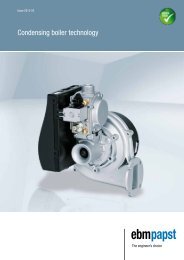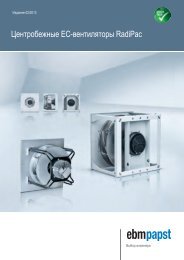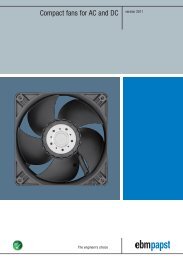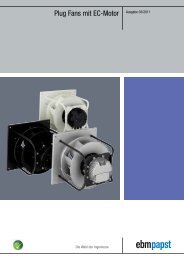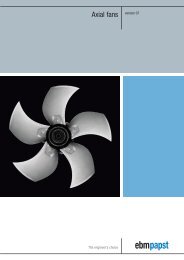Drive technology for AC and DC
Drive technology for AC and DC
Drive technology for AC and DC
You also want an ePaper? Increase the reach of your titles
YUMPU automatically turns print PDFs into web optimized ePapers that Google loves.
Motor <strong>technology</strong>Electronic motor commutationTo produce a motor torque, the field windings in the stator of the motorreceive a current. The resulting magnetic field reacts against the permanentmagnetic field of the rotor, generating a torque.In order to ensure that the rotor continuously rotates, the current in thewinding must be commutated. In conventional <strong>DC</strong> motors, the commutationnecessary <strong>for</strong> constant rotation of the armature is achieved mechanicallyusing a commutator <strong>and</strong> brushes. Thanks to modern semi-conductor <strong>technology</strong>,this mechanical commutation can be replaced by a non-contacting,electronic circuit.The magnet is in the <strong>for</strong>m of a rotor, <strong>and</strong> field windings that are distributedover the circumference of the stator are each connected to the voltagesource via one or more transistor switches. The transistor switches arecontrolled depending on the position of the magnetic rotor. For determiningthe position of the rotor, Hall effect sensors are used-, one or more rotorposition encoders positioned on the printed circuit board of the motor. Suchmotors are referred to as electronically commutated motors, in short ECmotors.The most distinct advantages of this type ofmotor: The EC motor sidesteps the disadvantagesassociated with the mechanical commutatorsuch as, commutator wear, brush friction,accumulation of dust due to abrasion, noises,starting difficulties due to corrosion of thecommutator segments <strong>and</strong> high-frequencyinterference caused by sparking.A distinguishing feature of the EC motor is itscompact size. Furthermore, the commutationelectronics can be equipped at comparably lowcost with an electronic control unit <strong>for</strong> maintaininga constant speed. The rotor position sensorsare additionally used <strong>for</strong> determining theactual speed. The considerably better servicelife values in comparison to the brush <strong>DC</strong>motors are also a major feature.8



